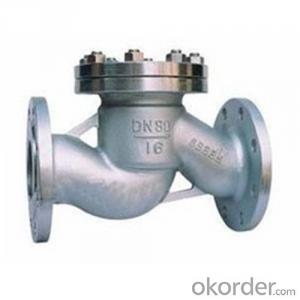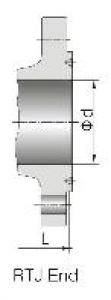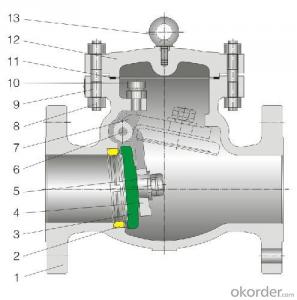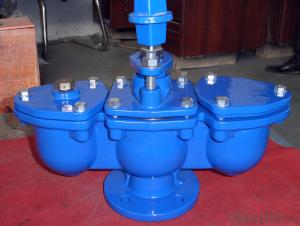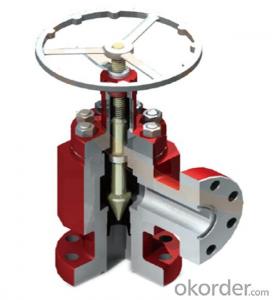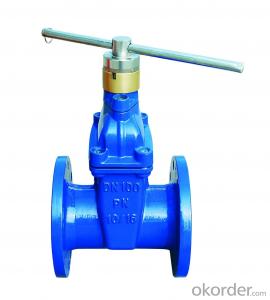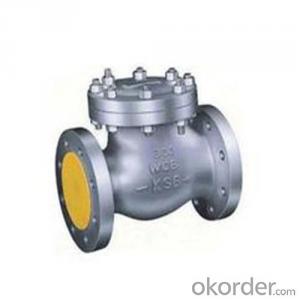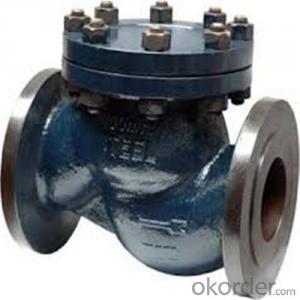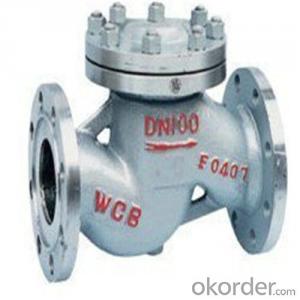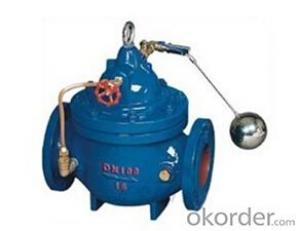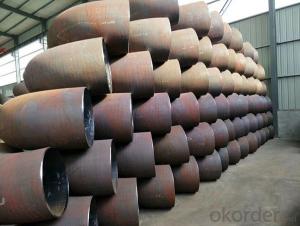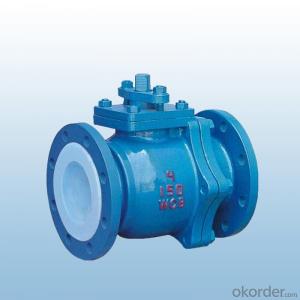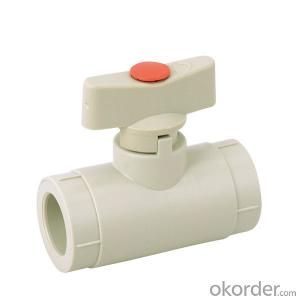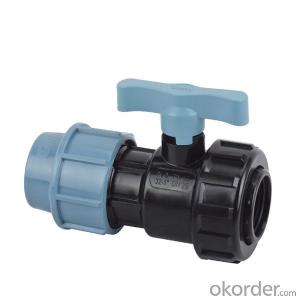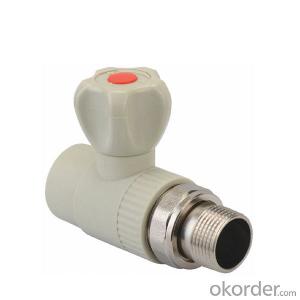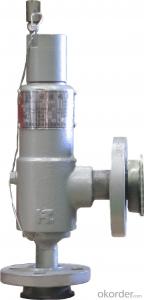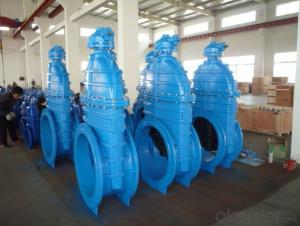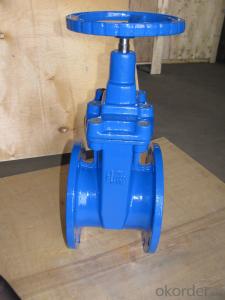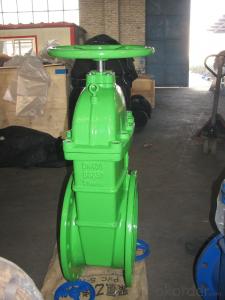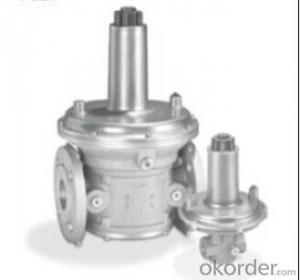API Cast Steel Lift Check Valve Size 650 mm
- Loading Port:
- Shanghai
- Payment Terms:
- TT OR LC
- Min Order Qty:
- 10 pc
- Supply Capability:
- 100 pc/month
OKorder Service Pledge
OKorder Financial Service
You Might Also Like
API Cast Steel Lift Check Valve 150 Class
The features of Cast Steel Lift Check Valve
Bolted Bonnet;Swing and lift disc;Metallic seating surfaces.
Body and Bonnet Connection of Cast Steel Lift Check Valve:
The body and bonnet of Class150~Class900 check valves are usually with studs and nuts.And the body and bonnet of Class1500~Class2500 check valves are usually of pressurized seal design.
Body-To-Bonnet Joint of Cast Steel Lift Check Valve:
Stainless steel + flesible graphite wounded gasket is used for Class 150 and Class 300 check valve;Stainless steel + flexible graphite wounded gasket is used for Class 600 check valve,and joint gasket is also optional for Class 600 check valve;Ring joint gasket is used for Class900 check valve;Pressurized seal design is used for Class 1500~Class 2500 check valves.
Seat of Cast Steel Lift Check Valve:
For carbon steel check valve,the seat is usually forged steel.The sealing surface of the seat is spray welded with hard alloy specified by the customer.Renewable threaded seat is used for NPS<10 check="" valves="" and="" welded="" on="" seat="" can="" be="" also="" optional="" if="" being="" requested="" by="" the="" customer.welded="" is="" used="" for="" nps="">12 crbon steel gate valves .Forstainless steel check valve,integral seat is usually adopted ,or to weld hard alloy directly integrally.Threaded or welded on seat is also optional for stainless steel check valve if being requested by the customer.
Parameter of Cast Steel Check Valve:
Standard Criteria | ASME/ANSI/API customize |
Pressure Rating | 150 Class 300 Class 600 Class 900 Class 1500 Class 2500 Class customize |
Valve Size | 50 mm 65 mm 80 mm 100 mm 125 mm 150 mm 200 mm 250 mm 300 mm 350 mm 400 mm 450 mm 500 mm 600 mm 650 mm 700 mm 750 mm |
2 inch 2.5 inch 3 inch 4 inch 5 inch 6 inch 8 inch 10 inch 12 inch 14 inch 16 inch 18 inch 20 inch 24 inch 26 inch 28 inch 30 inch customize | |
Actuator | Automatic customize |
Connection | Butt Welding Flange RF Flange RTJ customize |
1-Body Material | A216 WCB A351-CF8 A351-CF8M customize |
2-Seat ring | A351-CF8 A351-CF8M A105+13Cr Tool Steel+A105 customize |
3-Disc | Tool Steel+A216 WCB A351-CF8M A351-CF8 A216 WCB+13Cr customize |
4-Arm | A351-CF8 A216 WCB A351-CF8M customize |
5-Nut | A194 8M A194-8 A194 2H customize |
6-Arm pin | A182-F6a A182-F316 A182-F304 customize |
7-Yoke | A351-CF8 A351-CF8M A216 WCB customize |
8-Bonnet nut | A194 8M A194-8 A194 2H customize |
9-Bonnet bolt | A193-B8 A193-B8M A193-B7 customize |
10-Bolt | A193-B7 A193-B8 A193-B8M customize |
11-Gasket | graphite+304 graphite+316 customize |
12-Bonnet | A216 WCB A351-CF8M A351-CF8 customize |
13-Eye bolt | A181 customize |
Design Standard | API 6D BS 1868 customize |
Connection Standard | API 605 ASME B 16.25-2007 ASME B 16.47A ASME B 16.47B ASME B 16.5 MSS SP-44 customize |
Test Standard | API 598 API 6D customize |
Face to Face | ASME B 16.10 customize |
Pressure-temperature ratings | ASME B 16.34-2004 customize |
Wall thickness dimension | API 600 BS 1868 |
FAQ of Cast Steel Check Valve:
Q1:I can’t find the type of steel check valve which I need. what can I do?
The chart above only lists out some common composition of steel check valve parts.We may provide other different parts material composition according to the customer's request or the actual valve working condition.
Q2:Which certification do your products pass?
Our products are in accordance with ISO 9001、ISO 14001、API 6A、API 6D、TS CE、API607/6FA/BS6755.
- Q:Im putting in a new EGR Valve for my 94' Mazda MX-3 V6 1.8L and i was wondering if anyone had a guide or some special tips on what or what not to do...Thanks.
- One thing people don't do is bring the old EGR Valve with them to match it up with the new one before leaving the auto parts store. I would suggest doing this FIRST, if it is possible to get a ride to the parts store. I know you can't do this if the MX-3 is your only car lol. Be careful and take your time, do not rush and take digital pics before job is started so you know how or where things were durring re-assembly. And I do hope it is warm wherever you are doing this job,lol. Good question!
- Q:How do I adjust the valves on a 96 Blazer, 4.3 V6? When we tighten them to torque specs there is no compression, then when we loosen them and get compression, they loosen up to loose after its been running...any help!, THanks!
- THEY AREN'T ADJUSTABLE!!! The problem is the lifters are filled with oil and they won't compress to the point where the valves close all the way. You have to torque them to the proper setting, then turn the engine by hand untill the valves (lifters) have all had time to bleed down in the open position. It's a pain but you have to turn the engine till a few valves are open, then wait a few hours, mark those valves or write them down on a piece of paper, then turn it till some other ones are open, etc etc.. When you put lifters in new there's always some air in them, but when you take the pressure off a used one the spring pushes the plunger inside the lifter up, and it sucks in oil and becomes overprimed. By letting then sit for a while in the open position, the valve spring will push some of the oil out of the lifter, and allow it to reset to the proper adjustment next time the valve closes. Hence the term Hydraulic valve lash adjuster (lifter for short) DON'T WORRY YOU DON'T NEED A CAM OR NEW LIFTERS. THAT HAS HAPPENED TO ME DOZENS OF TIMES.
- Q:I'm going to replace a valve guide and wondering how I should do it.Should I drill into the existing valve guide to the point it's small enough to pinch with some pliers and pull it out?When I put the new one in, should I use a wooden dowel and an air nailer to pound the guide into place?The more info. the better. It's my first time doing this.Thanks!
- Ohhhh man. NO DRILLS. I assume you are referring to an Aluminum Cylinder head. To do it correctly you need a drift punch that has a pilot size of the valve stem, and an outside diameter that is just a few thousands smaller than the guide. Disassemble the head completely, put in Moms oven at the highest setting it will go to ( 5-6 hundred degrees ) Pound old guide out from the combustion camber side. ( have every thing ready to go this FFer will be hot ). Coat new guide with something like STP, put in freezer, carefully align it, then slam it home from the valve train side, don't pussy around, get it in before it attracts the heat of the head, if you stop or it stops you will have to repeat the entire process. If you gall the Aluminum ( say O-**** ) Since you have to hit this thing fairly hard you will need to refinish the inside of the guide with the appropriate reamer. Then refinsh Valve seat ( they never, NEVER line up perfectly )
- Q:like my Acura has a 16v 4clyinder engine , and i dont know what valves does , the more vavles the faster?
- the more valves, the more complicated the engine, but yes, more power. a regular 4cyl engine has 8 valves, or 8V. 1 intake valve, 1 exhaust valve. (4x2=8) in a 16v engine, it can be 2 intake valves, 2 exhaust valves 4x(2x2)=16 there are engines with up to 32 valves, those are usually in the 8cyl engines. as a valve opens, it allows air into the combustion chamber, after the burn, the exhaust valve opens to let the burnt fuel out and thru the tailpipe. the faster the air can excape, the faster new air can enter. so more valves, more power. problem is, if they bend or break, very expensive to repair.
- Q:As title.What's an easy way to remember: mitral valve leaflets are anterior and posterior leaflets; tricuspid leaflets are anterior, posterior, and septal (medial); aortic valve leaflets are left, right, posterior leaflets; pulmonary valve leaflets are left, right, anterior leaflets?It's easy to remember all but one valve (mitral) have three leaflets each. Physically aortic root sits behind pulmonary trunk, I guess that makes it easy to remember aortic valve has left, right, Posterior; and that pulmonary valve has left, right, anterior leaflets. Where I'm running out of ideas now is how to remember tricuspid has anterior, posterior and septal leaflets... Please help.Thanks.
- The tricuspid valve has three leaflets which are thin and membranous with commissures that appear more like indentations than true commissures. The TV apparatus is similar to the mitral valve but has greater variability and thinner leaflets. The three leaflets are the anterior, septal and posterior leaflets, with the anterior and septal being larger than the posterior leaflet. TV= tricuspid valve tri-cuspid=3(three leaflets) leaflets=3leaflets Tricuspid: Having three flaps or cusps. The valve that is called the tricuspid valve is situated between the right atrium and right ventricle and permits blood to flow only from the atrium into the ventricle. The aortic valve in the heart also has three cusps. Tricuspid valve (Anat.), the valve, consisting of three triangular membranous flaps, at the opening of the right auricle into the right ventricle in the heart of most mammals; -- sometimes called the tricuspid valves, each flap being regarded as a valve. Take care as always
- Q:A diabetic patient undergone CABG having aortic valve problem.Cardiologist suggested valve replacement
- Can be cured by valve replacement... alternatively, if you can't/won't go through open heart surgery then you may be able to get valvuloplasty. A balloon is used to stretch the valve open. This does not last nearly as long as replacement, but avoids surgery. A third alternative would be to contact one of the percutaneous valve REPLACEMENT centers (Mayo, Cleveland Clinic, Columbia). This is an experimental procedure which replaces the valve using catheters instead of surgery. Advice offered here is not meant to be a replacement for proper evaluation and examination by a qualified medical professional and should not be construed as such.
- Q:Its a 1981 Monte Carlo SS with a GM 350 crate motor. There is oil all over the heads valve covers. It isn't my car, but I was thinking of buying it..Thank you.
- valve cover gaskets leaking, oil cap not tight enough or the intake gasket leaking.
- Q:The timing belt in my 93 honda accord went out going about 45mph,i then paid someone 150 dollars to put in the new timing belt and it began to shake and he told me that the valves were bent.....i went to a local mechanic and he told me that the valves in honda accords dont bend...is this true?and how much is an average cost to repair the valves and pay someone to do all this?can i do it myself?
- OK the valves int eh honda when the timing belt goes will impact the top of the cylinder. Now wether this bends them or not isn't the issue what is the issue is that there is damage to what is called the top end of the engine. A new head, is your best bet. As long as it didn't crack a piston when the valve hit the piston. If you are mechanically able I would go get a used head from a junkyard. go to a shop and have it checked for cracks etc. and have the valves checked. Not necessarily a valve job done unless it needs it. Put that on and that should fix your shaking issue. This is the route I have taken on numerous engines.
- Q:I'm using a Yamaha double horn, and I reeeeeeealllyyyyy need to work on an audition for Monday. But my second valve is coming up slowly, which is a huge trouble 'cause all the pitches sound wrong!What do I do? I tried oiling the valve, that hasn't worked.
- Try oiling the top and bottom bearing. One is located under the valve cap, at the top of that stem. You can see it turn when you move the valve. Put a few drops there and then move it. For the bottom bearing you need to turn the horn over and put some oil in the crack where the valve comes out of the valve case, under the string area. Again, oil it and let the oil get in while you move the valve.
- Q:My cougar needs new EGR valve. They squeezed the 4.6 litre engine into it. My question is, how hard is it to get out and then back in? I can barely see the top of it behind the intake manifold so don't want to get it off and not be able to get it back in. What size bolts hold it in? I'm sure they are metric. Any help would be greatly appreciated.
- How do you know that you have a bad valve? Are you just going by the code,or did you have it checked by a tech.? I have replaced very few valves.If you have a v vacuum pump you can check your egr valve. Apply vacuum an it should hold. Now with engine running apply vacuum does the engine stubble or stall? If the valve holds vacuum its good, an if engine stubble's the ports are not plugged. If all that checks out good the problem is most likely the DPFE sensor. If i were there with a scanner i could tell you exactly what wrong.Its not impossible to change the valve take your time an be patient.
1. Manufacturer Overview |
|
|---|---|
| Location | |
| Year Established | |
| Annual Output Value | |
| Main Markets | |
| Company Certifications | |
2. Manufacturer Certificates |
|
|---|---|
| a) Certification Name | |
| Range | |
| Reference | |
| Validity Period | |
3. Manufacturer Capability |
|
|---|---|
| a)Trade Capacity | |
| Nearest Port | |
| Export Percentage | |
| No.of Employees in Trade Department | |
| Language Spoken: | |
| b)Factory Information | |
| Factory Size: | |
| No. of Production Lines | |
| Contract Manufacturing | |
| Product Price Range | |
Send your message to us
API Cast Steel Lift Check Valve Size 650 mm
- Loading Port:
- Shanghai
- Payment Terms:
- TT OR LC
- Min Order Qty:
- 10 pc
- Supply Capability:
- 100 pc/month
OKorder Service Pledge
OKorder Financial Service
Similar products
New products
Hot products
Hot Searches
Related keywords
